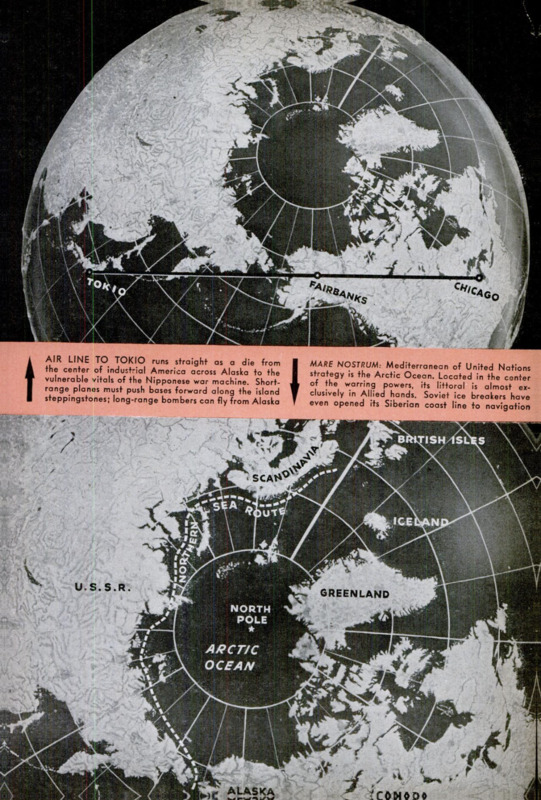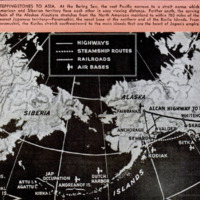-
Titolo
-
How We Can Smash Japan with Bombers from Alaska
-
Article Title and/or Image Caption
-
How We Can Smash Japan with Bombers from Alaska
-
extracted text
-
SHALL we invade Japan? If the idea is
bold, it is on no less grand a scale than
the general objectives of the United
Nations in the Pacific. To attain those objec-
tives, we obviously will have to:
Strip Japan of the mandated islands that
she accepted as a trustee, and fortified for
keeps.
Evict her from the vast territories now
overrun by her barbarians in modern dress,
and restore them to their rightful owners.
Disarm her of warships, guns, and planes.
Eliminate from ruling power the military
clique, responsible only to an acquiescent
Emperor, that has made her the trouble-
maker of the Far East.
For months after Pearl Harbor, however,
we were able to wage no more than a de-
fensive war. The turning point came with
Guadalcanal in the Solomons, where the
cream of our fighting forces dominated the
island after months of fighting the Japs.
“From now on the going will be tougher,”
says Admiral Chester W. Nimitz, Com-
mander in Chief of the United States Pacific
Fleet. “It is our job to destroy the enemy's
ships and planes and to neutralize his is-
lands’ strong points, as we drive toward the
‘positions from which we can reach with our
shells and our bombs his industrial nerve
centers.”
How long will it take? Because we can
build ships faster than can Japan, our mar-
gin of superiority in warcraft and cargo
vessels grows constantly. But time is not
wholly on our side, for it enables the Nip-
ponese to fortify and consolidate their con-
quests. And every year of war adds to our
mounting toll of blood and treasure.
From China, a powerful air offensive
might be launched at Japan—if the doughty
Chinese only had the planes, the gasoline,
and the bombs, The problem is how to get
United Nations aid to blockaded China,
other than in driblets by air over the peril-
ous Himalayan route from India. Recap-
ture of Burma and its famous road has
become an avowed Allied aim—but, again,
how long will it take?
Speculation shifts to an assault on Japan
from a direction that ordinary maps hardly
suggest, but of which Nippon itself is
acutely and nervously aware. The jumping-
off place is Alaska.
As for the mechanics of such a plan, the
comparatively short range of fighter and
torpedo planes suggests an advance by the
steppingstones of the Kurile Islands, start-
ing with the seizure of Paramushiri—Ja-
pan’s northernmost naval base. This would
be done with the co-operation of a naval
task force, including aircraft carriers. On
the other hand, unescorted bombers and
transports—which have proved their ability
to evade Zero fighters—could fly nonstop
from advanced Alaskan bases to Japanese
islands. Landing places in China would
augment the load of bombs or troops they
could carry. Given time to build them, enor-
‘mous aircraft as large as, or larger than, the
Army's experimental Douglas B-19 and the
Navy's Glenn Martin flying boat Mars
would be especially suited for the task, with
their range of almost 8,000 miles.
So far, Soviet Russia has been left out
of the question, since it has not declared
war upon Japan at the time these words
go to press. But if this day-to-day neu-
trality should suddenly end, or if we were
to have the use of Red air bases, our at-
tack would become infinitely simpler.
Bombers, bombers, and more bombers—
these are the weapons that commend them-
selves to take the fight out of the Japanese.
A single raid on Tokio was enough to give
them jitters. Imagine, then, the effect of
round-the-clock bombing with everything
we have. Even comparatively light planes
could sow enough incendiary missiles to
wreak havoc among the tinderbox struc-
tures of Tokio. Heavy aircraft would carry
“block buster” demolition bombs to raze
their naval bases, their industrial centers,
their seaports, their airports, and their rail-
road lines. Let us have no compunction
about leveling everything that comes be-
neath the bomb sights. We have only to
remember the fire-swept shambles that Nip-
ponese bombers left of Shanghai, at the
very beginning of their undeclared war
against China, to know we will be speaking
the only language that the Japs understand.
Japan presents almost an ideal bombing
target. Although the total area of her
principal islands is more than half the size
of Germany, most military objectives are
concentrated in four small sectors. Hit
Tokio and its harbor, Yokohama; Osaka
and near-by Kobe, respectively the largest
city and leading seaport of the country;
Yawata, vital steel center; and the ship
yards of Nagasaki. That is the simple for-
mula for knocking out the enemy.
Granted an element of luck and surprise,
our bombers and torpedo planes might turn
the tables of Pearl Harbor, and save our
Navy considerable trouble in dealing with
the Japanese battle fleet. Rightly or wrong-
ly, opinion has been advanced that if the
Japs had pressed home their temporary ad-
vantage at Hawail, their flag might now be
flying over the islands. By the same argu-
ment, a bombing barrage upon Japanese
defenses could prepare the way for an in-
vasion in force. Seize or destroy the cen-
ters of supply for Japan's oversea con-
tingents, and most of them would be at the
mercy of hostile peoples.
At the top of the world, everyday geogra-
phy turns topsy-turvy. Look at a map of
the polar regions, and you will see our
strategic “Mediterranean” —the Arctic
Ocean. Well might it be called Mare Nos-
trum—our sea—since, with the sole ex
ception of Scandinavia, its entire rim lies
in the hands of the Allied powers. Aviation
makes it a short cut to all parts of the
Northern Hemisphere. Soviet ice breakers
have even opened a shipping lane along the
northern shore of European Russia and
Siberia,
Now look a little southward, where the
Bering Sea joins the Arctic and Pacific
Oceans. The vast expanse of the Pacific all
but closes. Little
Diomede and Big Diomede Islands, Alaskan
and Siberian territory respectively, face
each other within easy viewing distance of
only a mile.
Farther south, the long chain of Alaska's
Aleutian Islands extends to within 750 miles
of Japanese territory. Here lies Paramu-
shiri, at the outer end of the Kuriles, which
form an extension of the four principal
Japanese islands—Hokkaido, Honshu, Shi
koku, and Kyushu—in lower latitudes.
‘This little study in geography has not es-
caped Oriental notice. Last June, a few
bombers bearing the Rising Sun emblem
paid brief calls on our advanced air base
of Dutch Harbor, in the Aleutians per-
haps as much to look us over as to set afire
several fuel tanks. Next, small seaborne
Jap forces moved in on some of the outer-
most, inhospitable islands of the Aleutian
chain_Attu, Agattu, and Kiska. They
brought seaplanes with them. U.S. Army
Air Forces promptly countered by setting.
up © base in the Andreanof Islands, several
hundred miles beyond Dutch Harbor. This
brought both American bombers and short-
range fighter escorts within striking dis-
tance of the hapless Japs, for whom an
occasional lifting of the bleak region's fogs
meant only a pelting with high explosives.
Now and then, U.S. men-of-war varied the
monotony with artillery fire.
What they were up to remains anyone's
guess. Propaganda for home consumption?
Weather observations? Attempts to estab-
lsh submarine bases? Patrol posts fo
Watch U.S. movements? Or, conceivably,
advance reconnaissance for a force to in
vade North America?
If the last, it may be observed that an
invasion route sometimes works both ways.
Our own end in Alaska, where 300 in-
fantrymen long guarded a territory bigger
than Germany and France combined, has
been made secure. A central air base at
Fairbanks and numerous coastal bases are
backed up with reinforcements and sup-
plies from the United States by sea, by air,
and now by the recently completed Alcan
Highway, an invulnerable inland route. In
turn, here are the means of striking a mor-
tal blow at the heart of Nippon.
-
Autore secondario
-
Alden P. Armagnac (writer)
-
American Museum of Natural History (photos)
-
Lingua
-
eng
-
Data di rilascio
-
1943-06
-
pagine
-
54-56, 202
-
Diritti
-
Public Domain (Google digitized)
-
Archived by
-
Matteo Ridolfi
-
Alberto Bordignon (Supervisor)



